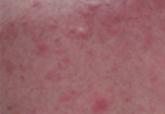Syphilis is reemerging, as evidenced by the increased incidence of primary and secondary syphilis cases. When syphilis presents as unusual skin lesions, it often is misdiagnosed. The cutaneous features of secondary syphilis, known as syphilid, occur in 80% of patients, and more than 95% of the eruptions are macular, maculopapular, papular, or annular. Nodular and pustular eruptions are infrequent. Although moth-eaten hair loss is the most typical sign, it is considered an uncommon manifestation of secondary syphilis. The frequency of alopecia syphilitica reported in the literature ranges from 2.9% to 7.0%. Another cutaneous feature of secondary syphilis is a mucous plaque, a macerated, flat, grayish, rounded erosion covered by a delicate soggy membrane. We describe a patient with scalp alopecia, perianal condyloma latum, and annular scrotal lesions resembling granuloma annulare.
